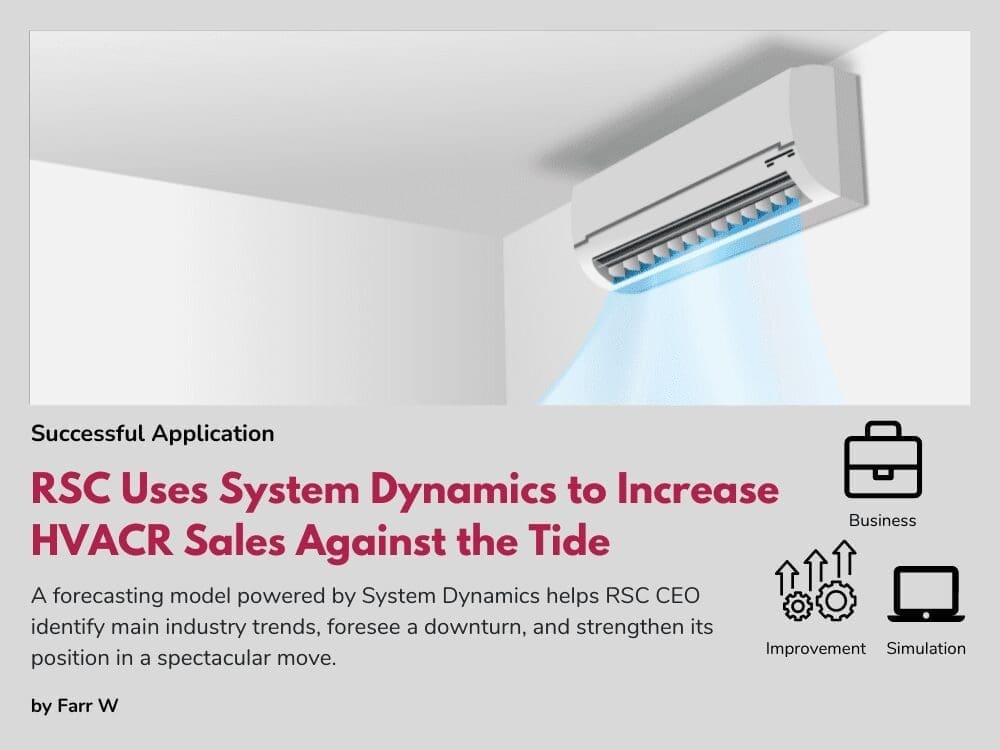RSC Uses System Dynamics to Increase HVACR Sales Against the Tide
“Using the proven Strategy Dynamic process focused our limited resources on organizing strategic issues, identifying the critical resources, and developing the insight to more rapidly create intuitive and actionable business strategy.”―Warren Farr, CEO, Refrigeration Sales Corporation
System Dynamic’s benefits do not have to be driven by outside consulting efforts. Sometimes, internal education and training lead to insights which cause a company to thrive and even evolve during the most tumultuous times. Take Refrigeration Sales Corp (RSC), during the downturn of the late 2000s. CEO-turned-modeler, Warren Farr, was able to see RSC’s revenue go up 25% in a market that saw sales go through a 25% decline, thanks to forecasts driven by SD modeling and insights gained during the process of developing those models.
RSC is a third generation privately owned family business located in Ohio, USA specializing in wholesale sales and support of Heating, Ventilation, AC and Refrigeration (HVACR) units. Over the years the company had expanded its business beyond just equipment sales to credit lending, technical support and training for many thousands of statewide contractors. At the time the HVACR industry itself had enjoyed three decades of continuous growth, and RSC had seen annual AC sales increases averaging 10%. But for the first time in years, these annual sales rates were decreasing. Competitors, and the company’s own customers, believed this to be a “temporary lull” caused by the economy as a whole and, along with more cautious suppliers, most parties were optimistic for the future. However, Warren, who had just taken the first of several courses in System Dynamics, believed that recent trends in 2001 signaled a new phase in the market’s development and that this historic growth would inevitably slow down more permanently.
Applying System Dynamics
Inspired by the notion of feedback stemming from inside the system rather than external causes, Warren applied the SD methodology to create long-term market forecasts; ones which were crucial to a company whose sales and profits were tied directly to the fortunes of market volume. Working off of the three views of the future in the figure below, Warren sought to find the underlying truth of the industry. While suppliers and customers were sticking with the “hope” prediction, and the company’s management was preparing for the “best guess”, information on the market’s installed base showed clearly that the “fear” scenario was in fact the appropriate response to prepare for.
A key systemic insight is this. The nature of durable goods, is that they are, well, durable. Sales levels for a durable product have the shape of a bell curve; sales of new units increase until the market becomes saturated, at which point new sales are mostly replacement or upgrades. Warren’s competitors and customers were blind to this basic truth, and fully expected demand to start rising again with the next recovery in the economy and in construction.
Sales levels for a durable product have the shape of a bell curve; sales of new units increase until the market becomes saturated, at which point new sales are mostly replacement or upgrades. Warren’s competitors and customers were blind to this basic truth, and fully expected demand to start rising again with the next recovery in the economy and in construction.
This saturation effect is simple enough to state – but how significant would it be, and over what time-scale would it play out? The dynamic model quantified the accumulation of the installed-base and internalized the feedback of declining first-time sales, allowing managers to observe reality playing out and refine their intuitions about the ebbs and flows of the industry’s growth cycle.
Not only was the approaching saturation point reducing the installation base for new AC units, but in a northern U.S. region like Ohio where an AC unit could last for 15 to 20 years, replacement sales were unlikely to fuel growth either. The model was predicting a 20% to 30% contraction in sustainable annual unit sales, which would be considered catastrophic in most markets.
U.S. Regulations Delay Market Contraction
The reaction to these insights was swift and not without controversy. In the years 2004 and 2005, sales spiked even higher than the hopeful prediction thanks to new US Dept. of Energy regulations which were causing contractors to stock up on older AC units before new minimum efficiency requirements took place and raised prices. But RSC stuck to its forecasting model. In an industry which had known nothing but growth for decades, RSC was downsizing its workforce, tightening customer credit limits and consolidating its inventory and warehouses. Both suppliers and customers thought these actions were short-sighted according to common industry logic and current record sales. But RSC’s uncommon logic would swiftly prove itself as the predicted market contraction came true. After 2005, sales entered an unprecedented crash, setting the market average back down to 1994 levels.
“The modeling provided a longer-term perspective, allowing RSC management to make these dramatic changes in company bandwidth over a period of about 3 years, avoiding the excess cost associated with rapid ‘cutting’.” ―Warren Farr, CEO, Refrigeration Sales Corporation
Forecasting Leads to Market Share Growth
Thanks to their SD forecasting efforts, RSC changes were proactive and planned, and not reactive with unintended consequences. Though RSC would have survived the industry downturn without modeling, the company was now in a prime position to diversify and take on new market share as competitors sought to shed expenses in a bid to stay afloat. New talents, territories, and market shares were taken from unprepared firms scrambling to adapt to the crash. In territories where the AC market saw a 30% contraction from 2000 to 2010, RSC saw a 25% increase in annual revenues and 30% increase in its sales locations.
RSC’s story highlights a number of points. First, managers need to regularly ‘step outside’ the day-to-day crush of business activity, and understand the fundamentals of what is happening in the market around them. Second, just being aware of principles – like market saturation – may not be enough. Often what is needed is modeling work to figure out the quantified, time-based consequences of these dynamics. Third, the company’s work highlights the advantage of making decisions with forethought and examination, rather than waiting for the impact of new market conditions to throw off business plans. The story reflects the simple but powerful insights that System Dynamics can bring to such questions. Clearly, RSC’s strategic change decision was very significant, enabling them to create new advantages over the competition.
Lastly, we can see that System Dynamics is not some highly technical tool only accessible to math whizzes, but a practical, accessible method that smart managers like CEO Warren Farr can learn to use to great effect.
OTHER SUCCESSFUL APPLICATIONS
System Dynamics Helps Evaluate Anticipatory Action on Cholera Outbreaks
Humanitarian agencies encourage anticipatory action in disaster response to cholera outbreaks in the Democratic Republic of Congo.
Management Design for Planted Forests in Japan Using System Dynamics
Hanno City in Saitama Prefecture used a system dynamics model to enable detailed analysis of labor requirements and changes in forest conditions.
Solving Bottlenecks in Dairy Production Facilities with System Dynamics
FriedslandCampina employed system dynamics to strategically enhance production efficiency in the midst of factory merging.
Upcoming Events

2024 International System Dynamics Conference
The International System Dynamics Conference is coming to Bergen! Save the date: August 4-8, 2024. We hope to see you there! #ISDC2024
Recent Posts
How Did En-ROADS Get 755,000 users? Lessons on Modeling, Interface Design, and Facilitation
This article discusses the En-ROADS climate model, detailing its robust modeling, intuitive interface design, effective facilitation, and strategic policy engagement for global impact.
Society Governance Updates
New System Dynamics Society leadership
Call for Presenters: Seminar Series
Share your insights in the System Dynamics Society Seminar Series. Submit your proposal and join a global community of experts
Join us
OTHER SUCCESSFUL APPLICATIONS
System Dynamics Helps Evaluate Anticipatory Action on Cholera Outbreaks
Humanitarian agencies encourage anticipatory action in disaster response to cholera outbreaks in the Democratic Republic of Congo.
Management Design for Planted Forests in Japan Using System Dynamics
Hanno City in Saitama Prefecture used a system dynamics model to enable detailed analysis of labor requirements and changes in forest conditions.
Solving Bottlenecks in Dairy Production Facilities with System Dynamics
FriedslandCampina employed system dynamics to strategically enhance production efficiency in the midst of factory merging.
Recent Posts
How Did En-ROADS Get 755,000 users? Lessons on Modeling, Interface Design, and Facilitation
This article discusses the En-ROADS climate model, detailing its robust modeling, intuitive interface design, effective facilitation, and strategic policy engagement for global impact.
Society Governance Updates
New System Dynamics Society leadership
Call for Presenters: Seminar Series
Share your insights in the System Dynamics Society Seminar Series. Submit your proposal and join a global community of experts
Upcoming Events

2024 International System Dynamics Conference
The International System Dynamics Conference is coming to Bergen! Save the date: August 4-8, 2024. We hope to see you there! #ISDC2024


